About Pompeii
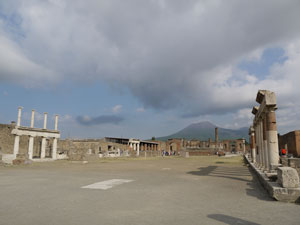 Pompeii is one of Italy’s most famous attractions: an entire Roman town which was smothered under volcanic ash in 79 AD. A UNESCO World Heritage Site, Pompeii lies south-east of Naples (Napoli), close to the southern slopes of Vesuvius (Mount Vesuvius, Vesuvio), the volcano whose eruption destroyed the town. The nearest airport is Naples Capodichino, and the archaeological zone is easily combined with a city break, a seaside holiday or a tour of southern Italy.
Pompeii is one of Italy’s most famous attractions: an entire Roman town which was smothered under volcanic ash in 79 AD. A UNESCO World Heritage Site, Pompeii lies south-east of Naples (Napoli), close to the southern slopes of Vesuvius (Mount Vesuvius, Vesuvio), the volcano whose eruption destroyed the town. The nearest airport is Naples Capodichino, and the archaeological zone is easily combined with a city break, a seaside holiday or a tour of southern Italy.
Visiting Pompeii is an amazing experience. It doesn’t take much imagination to picture the Roman town living around you. The presence of Vesuvius – appearing at the end of a street or over a ruined wall – is a constant reminder of the disaster which had the perverse effect of preserving much of the ancient city’s fabric. The ruins are fascinating, mesmerising and poignant at the same time.
Note that the modern Italian town on the site is called Pompei (with one ‘i’). Clustering alongside its ruined predecessor, it makes a practical base if you want to spend a full day or longer visiting the ruins. You can read more on travel, transport and accommodation further down this page.
The history of Pompeii
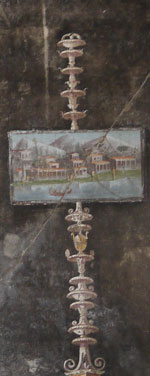
Pompeii was a fairly unremarkable Roman town close to the sea in southern Italy, and close, too, to Vesuvius. Then assumed to be an innocent mountain, the volcano is now considered to be one of the most dangerous in the world. Pompeii was an everyday working town which had been in existence for several centuries. It was home to tradesmen and farmers, with the rich and poor living side by side. Among those recorded in evidence around the archaeological site are bakers, house-painters, soldiers, wives, children, slaves and prostitutes. The elegance of some of the town’s villas proves the Pompeii was, or had been, home to some very wealthy families.
Among the interesting incidents of Pompeii’s history is the occasion 160 years before the eruption, when Pompeii joined an unsuccessful rebellion against ally Rome. Pompeii was besieged by the Romans (bombardment damage can still be seen in the city walls). After the revolt was quashed, Pompeii became a Roman colony, with its native Oscan language officially replaced by Latin. Roman ex-soldiers moved in, increasing the population. Like most provincial Italian towns of the era, Pompeii had passed through several changes of rule and twists of fortune. Given the town’s long history and the jigsaw-pieces of evidence which have been found, Pompeii is subject to ongoing analysis and re-evaluation by archaeologists and historians, with more information being pieced together as time goes on. Large areas of ancient Pompeii remain unexcavated, and may hold further clues to the lives and deaths of the people of Pompeii.
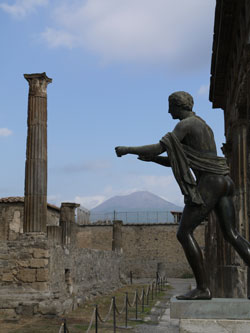
The town as it is now does not just bear damage from the one big eruption. The geological instability of the zone had resulted in a significant earthquake 17 years prior to the town’s final cataclysmic destruction, and Pompeii still bore the scars of this event when Vesuvius erupted. Some buildings had never been restored, and others were in the process of restoration. A series of earth tremors were felt in the weeks leading up to the eruption, and it’s thought that the majority of Pompeii’s inhabitants had already fled the town. Others, though, remained until it was too late. The most moving exhibits from Pompeii are the casts of bodies found among the ruins. Created by pouring plaster into the voids left by decaying bodies, these casts preserve the form, the posture and the clothing of the eruption’s victims. Some were found cowering indoors in family groups, others were on the road leaving town, carrying their valuables in a desperate attempt to escape. Of the luckier inhabitants, several appear to have returned after the eruption, burrowing through lava to salvage (or steal) what they could. The town itself was abandoned, and it was only in the 18th century that excavations began to bring to light the ruins along with the treasures and the tragedies they contained. As well as looters, both in antiquity and modern times, the ruins of Pompeii were severely damaged by Allied bombing in the Second World War, and parts have been reconstructed.
Although the modern visitor doesn’t see Pompeii exactly as it would have been on a typical day in antiquity (it isn’t quite “frozen in time”), it is still possible to stand in a Roman street, bordered by the walls of Roman buildings, looking at Roman graffiti, and – without a great leap of the imagination – picture the bustling urban life of antiquity. You can get a real sense of the elegance of private Roman villas, their colourfully-painted rooms grouped around pretty courtyard gardens, as well as the more utilitarian interiors of bars and bakeries.
Visiting practicalities
The archaeological site is open every day from 8.30am until 5pm in the winter and 7.30pm April-October. Admission costs €12 at the time of writing, and you can also buy combined tickets with Herculaneum and other local sights.
Pompeii is a vast site, and parts of the city are still not uncovered. Preserving and maintaining the ruins is a huge and expensive job and questions are frequently raised over the upkeep of the parts currently exposed. Areas of the site are kept closed, and some of the best-preserved buildings are open only occasionally, or opened only for special tours. Don’t be shy about approaching the site’s wardens and asking about nearby buildings. They may not be able to unlock the gates, but they may tip you off about opening times. If you see an escorted group being led into a ‘closed’ villa, you may be able to slip in with them if you ask nicely and keep your presence brief and discreet.
The size of the ancient town is daunting, and visitors really need a map and/or guidebook. (You can find maps on the site and online in advance, such as this one). Sit down in advance, or after arrival, to plan out a rough itinerary. Don’t spend ages on the first buildings you pass – there will be plenty more later and you can always visit these on the way out, anyway. Wear comfortable shoes, take a water bottle and sun protection in summer (you may be really glad of a hat or a parasol), and pace yourselves. It is much better to spend three-quarters of a day here with breaks for rest and refreshment than to attempt a feverish whistle-stop tour. Three or four hours would be a reasonable time to allow; in two hours you can see a fair amount of the site, but may feel rushed. There are drinking-water taps where you can refill your bottle, and there is a cafe in the site – near the Forum – where you can buy guidebooks as well as food.
Statues, artefacts, mosaics and wall-paintings from Pompeii are among the treasures kept in the Museo Archeologico Nazionale in Naples. If possible, you should visit the museum too, for a more complete picture of the ancient city. Reading some background before you go – for example, Mary Beard’s readable book Pompeii: The Life of a Roman Town – will also help you to get the most from your visit.
Highlights of Pompeii
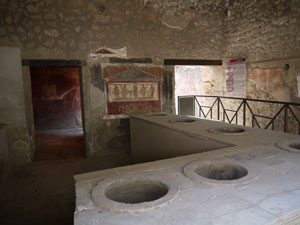
After entering through the Porta Marina, one of the first major landmarks you’ll reach is the town’s Forum. This large open space would have been the heart of the town – although some of buildings may still have been in ruins after the earlier earthquake. Look out for the marketplace, the Macellum, which houses some of the tragic body-casts.
The Brothel (Lupanare) is one of the most-visited sights of Pompeii. Tourists queue to pass through the poky environs of this old brothel, with small rooms containing stone beds, and wall-paintings advertising the services offered. This isn’t the only place in Pompeii to see erotic Roman art, but it is a fascinating sight and one of the easiest to find. The building’s function provides an obvious logical reason for the presence of the pornography here, but elsewhere, explicit decor suggests that Pompeiian attitudes to eroticism were strikingly relaxed compared with modern ones, with saucy scenes used to decorate villa walls. The phallus was a good-luck symbol, and is a recurring feature of the city’s art and architecture.
Pompeii’s villas are identified by romantic-sounding names, often based on surviving wall-painting themes or early assumptions about the building’s past. The House of the Tragic Poet boasts the famous ‘Beware of the Dog’ (“Cave Canem”) mosaic depicting a black guard dog. The House of the Faun, named after a small bronze statue found here, was the largest villa in Pompeii, and was an elegant historic residence at the time of the eruption, much of its decor two centuries old even then. The Villa dei Misteri, outside the city walls, is famed for its mysterious series of wall-paintings. There is an exit to the site here.
Although not all the villas of Pompeii are open at the same time, by exploring the stone streets with a map, the visitor can come across many other highlights off the main tourist trail. Many villas still contain amazing wall-paintings. There are several ancient bakeries dotted around the site, public baths, and fast-food taverns. Via dell’Abbondanza, leading towards the amphitheatre, is lined with a fascinating range of buildings.
Pompeii’s amphitheatre is the oldest surviving Roman amphitheatre, and was the setting for gladiatorial combats. Twenty years before the eruption a huge brawl broke out here between rival supporters from Pompeii and a nearby town, which led to questions being raised in Rome and the temporary closure of the amphitheatre. Note that the amphitheatre is at the far end of the site from the Porta Marina entrance, and it is a long walk. There is another entrance/exit to the site close by.
Pompeii/Pompei travel and transport
Pompeii has three entrances: Porta Marina (Marine Gate), Piazza Esedra and Piazza Anfiteatro. The most straightforward way to reach the site is to catch the Circumvesuviana railway line from Naples in the direction of Sorrento, alighting at Pompei Scavi – Villa dei Misteri (scavi means excavations). Trains are roughly half-hourly and the journey takes half an hour. In Naples trains depart from Napoli Garibaldi, which is alongside Stazione Centrale, the principal mainline train station. If you are based in Sorrento, the Circumvesuviana journey also takes half an hour.
Pompeii is easily visited from Naples and Sorrento, both good bases for a holiday. It is also a feasible day trip destination from the Amalfi Coast, the Bay of Naples islands and Paestum. However, the journey by public transport from these bases is long, and you may find it more comfortable to visit Pompeii en route to these destinations, spending a night nearby. It is possible to visit Pompeii as a day trip from Rome, but a better alternative is to visit “Rome’s Pompeii”, Ostia Antica – not as dramatic as Pompeii but still remarkable and much, much nearer.
Suggested itineraries
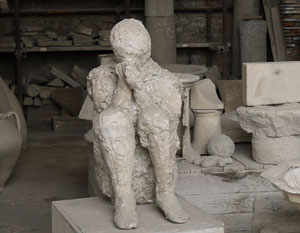
If you are visiting Pompeii, you really should also visit the archaeological museum in Naples, where most of the best exhibits are kept. Herculaneum, destroyed in the same eruption, is also a fascinating archaeological site, with some unique features. A nerve-jangling overview of the area (and the eruption) can be had from the crater of Vesuvius – an easy path leads up to the summit from a car park (and bus stop), and there are professional guides to accompany the intrepid on a crater-rim circuit. More Roman (and volcanic) sights in the area include Villa Oplontis, a fabulously-decorated Roman villa close to Pompeii, and the Pozzuoli coastline, where the Roman town of Baiae is now under the surface of the sea. After the hurly-burly of Naples, a relaxing break on Capri (more Roman ruins) or the Amalfi Coast makes a good getaway. A short ride down the railway line from Naples is Paestum, a hugely atmospheric Greek site where ancient temples stand in the countryside.
Accommodation
There is no real need to stay close to the site of Pompeii, unless you plan to visit two days in a row. Many travellers stay in holiday resort Sorrento, while staying in Naples is a practical choice for visiting the archaeological museum and Herculaneum. However, there is a good range of accommodation options nearby which might suit really keen visitors, or travellers touring Italy – and modern Pompei may be a more pleasant base than the hectic city of Naples. The nearest accommodation to the site includes Hotel Iside, a family-run 3-star, the popular Hotel Diana and the B&B Casa di Plinio.
On this site
Useful links